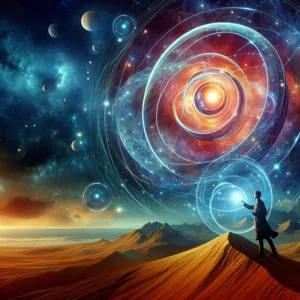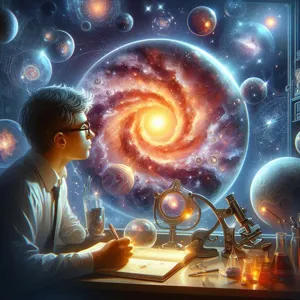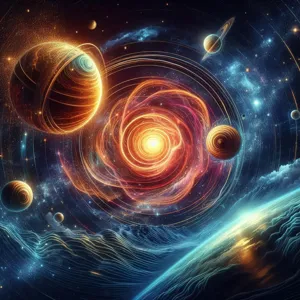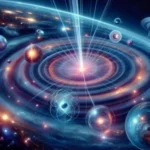The night sky has always captivated humanity, a vast canvas dotted with shimmering stars that ignite our curiosity and imagination.
But beyond the awe-inspiring beauty lies a fascinating realm of scientific inquiry—one that unravels the intricate processes of star formation. As we venture into the depths of the cosmos, astronomers employ an array of sophisticated tools and techniques, from powerful telescopes to advanced computer simulations, to decode the mysteries of how stars are born, evolve, and ultimately die. In this blog post, we will delve into the methods astronomers use to study star formation, exploring the cosmic nurseries where gas and dust coalesce under the influence of gravity, the role of massive stars in shaping their environments, and the breathtaking discoveries that have reshaped our understanding of the universe. Join us on this stellar journey as we unveil the cosmos and illuminate the wonders of star formation!
1. Introduction to Star Formation

The cosmos, with its vast expanse and shimmering celestial bodies, has long captivated the human imagination. At the heart of this intrigue lies the process of star formation, a phenomenon that not only shapes the universe but also offers profound insights into the lifecycle of matter. Stars are the fundamental building blocks of galaxies, influencing their structure, dynamics, and evolution. Understanding how these luminous spheres come into existence is crucial for astronomers who seek to unravel the mysteries of the universe.
Star formation begins in dense regions of molecular clouds, often referred to as stellar nurseries. These clouds are primarily composed of hydrogen, along with dust and other elements, creating the perfect conditions for new stars to ignite. As gravity pulls material together, clumps form and begin to collapse under their own weight. This process can take millions of years and involves a complex interplay of forces, including turbulence, magnetic fields, and radiation pressure.
As the core of these clumps contracts, temperatures rise dramatically, leading to the birth of a protostar. This early stage of a star’s life is marked by intense activity, where surrounding material continues to accrete, and outflows of gas are expelled. Eventually, when conditions are right, nuclear fusion ignites in the core, and a star is born, illuminating its surroundings and marking the beginning of its journey through the cosmos.
In this blog post, we will explore the intricate processes that govern star formation, the tools and techniques astronomers employ to study these celestial phenomena, and the implications of this research for our understanding of the universe. From the initial collapse of a molecular cloud to the birth of a new star, the story of star formation is one of wonder and complexity, reflecting the ongoing dance of creation that has been unfolding for billions of years. Join us as we delve deeper into this cosmic tale and unveil the mysteries behind the birth of stars.
2. The Lifecycle of Stars: An Overview
To truly appreciate the intricate process of star formation, it’s essential to first understand the lifecycle of stars, which unfolds over millions to billions of years, painting a vast cosmic tapestry that astronomers eagerly study. This lifecycle can be broken down into several distinct stages, each marked by significant transformations that reflect the star’s changing environment and internal processes.
The journey begins in stellar nurseries—vast clouds of gas and dust, known as nebulae, where gravity starts to pull particles together. As regions within these clouds collapse, they heat up, forming protostars. This initial phase is characterized by a rapid accumulation of mass and the onset of nuclear fusion, where hydrogen atoms fuse to create helium, releasing an immense amount of energy in the process.
Once nuclear fusion ignites, a star enters the main sequence phase, where it spends the majority of its life—several billion years for stars like our Sun. During this stable period, the star remains in a delicate balance between gravity pulling inward and the outward pressure from the fusion reactions occurring at its core.
As the hydrogen fuel begins to deplete, the star undergoes dramatic changes. For medium-sized stars, like our Sun, this means expanding into a red giant and shedding its outer layers, creating a beautiful planetary nebula. The core that remains transforms into a white dwarf, gradually cooling over billions of years.
In contrast, massive stars follow a more explosive path. After their hydrogen is exhausted, they swell into supergiants before experiencing a violent supernova explosion. This cataclysm not only scatters heavy elements across the cosmos but can also lead to the formation of neutron stars or black holes, depending on the remnant mass.
Throughout these stages, astronomers utilize advanced telescopes and observational techniques to gather data on the light emitted by stars at different points in their lifecycle. By studying the spectra, brightness, and other characteristics of stars, they can glean insights into their composition, temperature, and distance from Earth, uncovering the mysteries of star formation and evolution on a grand scale.
Understanding the lifecycle of stars not only enriches our knowledge of the universe but also highlights the interconnectedness of cosmic phenomena, illustrating how the birth and death of stars contribute to the continual cycle of matter in the universe. As astronomers unveil the complexities of star formation, they are piecing together the story of our universe—one star at a time.
3. Historical Perspectives on Star Formation

Understanding star formation requires a historical perspective that traces humanity’s quest to decipher the cosmos. From ancient civilizations to modern astrophysics, the journey of star formation study is rich with curiosity and scientific evolution.
In the early days, civilizations such as the Babylonians and Greeks pondered the night sky, attributing the twinkling stars to deities and myths. The early astronomers, armed with little more than their eyes and rudimentary tools, began cataloging the stars, attempting to understand their movements and relationships. The earliest models, such as the geocentric universe proposed by Ptolemy, offered limited insight into the dynamic processes of star formation, focusing instead on celestial navigation and astrology.
The Renaissance marked a turning point as figures like Copernicus and Galileo challenged long-held beliefs. Galileo’s use of the telescope unveiled a universe teeming with complexity, revealing moons orbiting Jupiter and the phases of Venus. These observations laid the groundwork for a more scientific approach to understanding celestial bodies, although the processes of star formation remained elusive.
The 19th century introduced the concept of nebulae—clouds of gas and dust in space—leading astronomers like William Herschel to speculate about their role in star birth. The realization that these nebulous formations could be the building blocks of stars began to take shape. However, it wasn’t until the 20th century, with advancements in technology and theoretical physics, that a more cohesive understanding emerged. The work of Edwin Hubble, who demonstrated the universe’s expansion, and the subsequent development of the Big bang theory positioned star formation within a broader cosmological context.
Today, astronomers utilize sophisticated telescopes and simulations to study the intricate processes of star formation. With the advent of radio astronomy and space telescopes like Hubble and the upcoming James Webb Space Telescope, we can now observe distant star-forming regions in unprecedented detail. By piecing together this historical tapestry, we appreciate how far we’ve come in our understanding of the cosmos and the birth of stars, reminding us that the quest for knowledge is an ever-evolving journey.
4. The Importance of Observational Astronomy
Observational astronomy serves as the cornerstone of our understanding of star formation, bridging the gap between theoretical models and the vast, intricate reality of the cosmos. Through powerful telescopes and advanced imaging technologies, astronomers can peer deep into the universe, capturing the faintest glimmers of light that reveal the birthplaces of stars.
At the heart of observational astronomy lies the use of various wavelengths of light—ranging from radio waves to gamma rays—each providing unique insights into the processes that govern star formation. For example, infrared observations allow astronomers to penetrate dense clouds of gas and dust where stars are born, unveiling stellar nurseries hidden from view in optical wavelengths. By studying these regions, researchers can gather data on the temperature, density, and composition of the materials involved in stellar genesis.
Moreover, observational astronomy enables scientists to gather empirical evidence that can validate or challenge theoretical models of star formation. By comparing simulations with real-world observations, astronomers refine their understanding of how stars evolve from simple gas clouds into complex systems, potentially hosting planets and life. This iterative process is crucial, as each new discovery prompts further questions and leads to deeper investigations.
Additionally, ground-based and space-based observatories contribute to a global network of collaborative research, allowing astronomers to share data and findings across borders. The synergy created by these partnerships enhances our collective knowledge and propels forward the field of astrophysics.
In essence, observational astronomy is not just about gazing at distant stars; it is a dynamic, ongoing effort to piece together the puzzle of the universe’s origins and the intricate dance of celestial bodies. Each observation adds a new thread to the tapestry of knowledge, illuminating the pathways through which stars are born, live, and ultimately, die. As we continue to unveil the cosmos, the importance of observational astronomy remains paramount in our quest to understand the very fabric of the universe.
5. Tools of the Trade: Telescopes and Instruments

In the vast expanse of the universe, where billions of stars are born and evolve over millennia, astronomers rely on an array of sophisticated tools to unveil the mysteries of star formation. Telescopes, both ground-based and space-borne, form the backbone of this exploration, allowing scientists to observe celestial phenomena at various wavelengths.
Optical telescopes, like the iconic Hubble Space Telescope, capture stunning images of star-forming regions in visible light, revealing intricate details of nebulae and stellar nurseries. However, the universe is not just a visual spectacle; much of star formation occurs in the infrared and radio wavelengths. This is where specialized instruments come into play. Infrared telescopes, such as the James Webb Space Telescope, penetrate the dense clouds of gas and dust that often shroud nascent stars, providing a clearer view of the processes at work.
Radio telescopes, like the Atacama Large Millimeter/submillimeter Array (ALMA), allow astronomers to detect cold gas and dust, facilitating the study of molecular clouds—the very birthplaces of stars. These instruments are designed to capture faint signals from distant galaxies and to map the intricate dynamics of gas flows and stellar interactions.
In addition to telescopes, astronomers employ a suite of other tools, including spectrometers, which analyze the light emitted or absorbed by celestial objects. By studying the spectral lines, scientists can determine the chemical composition, temperature, and motion of stars and their surrounding materials.
Moreover, sophisticated computational models and simulations run on powerful supercomputers help astronomers interpret the data collected from these observations. These models allow scientists to simulate the complex processes of star formation, from the initial collapse of gas clouds to the ignition of nuclear fusion in newborn stars.
Together, these tools and techniques empower astronomers to piece together the intricate puzzle of star formation, enhancing our understanding of not only how stars are born but also the broader processes that shape our universe. With each discovery, they bring us one step closer to understanding the cosmos and our place within it.
6. The Role of Gas and Dust in Star Formation
The vastness of space is not merely an empty void; it is a rich tapestry woven from gas and dust, the essential building blocks of star formation. In the cold, dark regions of space, these materials coalesce under the influence of gravity, creating dense clouds known as nebulae. These nebulae, often illuminated by the light of nearby stars, are where the journey of a star begins.
Gas, primarily composed of hydrogen and helium, fills the universe, while dust particles—tiny grains of carbon, silicon, and other elements—serve as the seeds for star formation. As gravity pulls these materials together, they begin to clump and collapse inward, raising temperatures and pressures at their core. This process, known as gravitational contraction, is crucial, as it leads to the ignition of nuclear fusion when the core reaches the necessary temperature—about 10 million degrees Celsius.
Astronomers utilize a variety of tools to study these processes. Observations in multiple wavelengths—radio, infrared, and visible light—allow scientists to peer into the dense clouds of gas and dust that obscure traditional optical views. For instance, infrared telescopes can detect the heat emitted by forming stars, revealing details about their size, mass, and temperature. Radio telescopes, on the other hand, can trace the molecular clouds in which stars are born, providing insights into their composition and the dynamics of star formation.
Moreover, the study of star formation is not just about observing individual stars; it encompasses understanding the role of stellar nurseries, such as the Orion Nebula, where thousands of young stars are born. In these regions, intricate processes occur, including the interplay between radiation pressure from nearby massive stars and the gravitational forces of the surrounding gas and dust, influencing how new stars evolve.
In essence, the role of gas and dust in star formation is a complex dance governed by the laws of physics. Through careful observation and analysis, astronomers unravel the secrets of these celestial factories, shedding light on how stars, and ultimately galaxies, come into being. Each new insight not only enhances our understanding of the cosmos but also deepens our appreciation for the intricate processes that have shaped the universe for billions of years.
7. The Process of Stellar Nurturing: Molecular Clouds

At the heart of star formation lies the enigmatic realm of molecular clouds, the cosmic nurseries where stars are born. These clouds, composed primarily of hydrogen molecules, along with dust and various other gases, are dense and cold—conditions that are ideal for the birth of new stars. Stretching across vast expanses of space, molecular clouds can span hundreds of light-years, resembling immense, ethereal cocoons.
The process begins when regions within these clouds become gravitationally unstable due to various factors, such as shock waves from nearby supernovae or the collision of two molecular clouds. As gravity pulls material together, denser clumps begin to form. Over time, these clumps collapse under their own gravity, leading to an increase in temperature and pressure at their cores. This is where the magic happens: the core of a collapsing clump eventually becomes so hot and dense that nuclear fusion ignites, giving birth to a new star.
Astronomers utilize a variety of sophisticated tools to study these molecular clouds and the star formation processes within them. Radio telescopes, for instance, can detect the faint emissions from the cold gases that comprise these clouds, revealing their structure and composition. Infrared observations allow scientists to peer through the dust that often obscures visible light, unveiling the hidden processes of star formation in real-time.
Moreover, recent advancements in computational astrophysics enable researchers to simulate the complex interactions of gas dynamics, gravity, and magnetic fields within these clouds, providing deeper insights into how stars are nurtured. By understanding the lifecycle of molecular clouds, astronomers not only chart the birth of stars but also glean clues about the evolution of galaxies and the universe itself.
In essence, molecular clouds are more than just interstellar gas; they are the fertile grounds from which new stars emerge, shaping the cosmos one stellar birth at a time. As we continue to unveil the mysteries of these celestial bodies, we inch closer to comprehending the intricate dance of creation that has been ongoing in our universe for billions of years.
8. Techniques for Studying Star Formation: Spectroscopy and Imaging
When it comes to unraveling the mysteries of star formation, astronomers employ a diverse array of techniques, with spectroscopy and imaging standing as two of the most powerful tools in their arsenal. Each method offers unique insights into the complex processes that give birth to stars, allowing scientists to peer into the depths of space and time.
**Spectroscopy** is a technique that involves analyzing the light emitted or absorbed by celestial objects. By dispersing light into its constituent colors, astronomers can obtain a spectrum that reveals vital information about a star’s composition, temperature, density, and motion. For instance, when studying star-forming regions, scientists look for specific emission lines in the spectra, which can indicate the presence of critical elements like hydrogen and helium, as well as more complex molecules such as carbon monoxide. These findings help illuminate the physical conditions within molecular clouds—the dense regions where stars are born—enabling researchers to understand the processes that trigger star formation.
On the other hand, **imaging** techniques allow astronomers to capture stunning visuals of star-forming regions across various wavelengths. From radio waves to infrared and optical light, each wavelength reveals different aspects of the star formation process. For example, infrared imaging can penetrate dense dust clouds that obscure visible light, revealing the embryonic stars nestled within. Telescopes like the Hubble Space Telescope and the upcoming James Webb Space Telescope are revolutionizing our understanding by providing high-resolution images that unveil the intricate structures of stellar nurseries. These images not only showcase the breathtaking beauty of the cosmos but also serve as crucial data points in tracking the growth and evolution of stars over time.
Together, spectroscopy and imaging form a complementary duo, allowing astronomers to piece together the narrative of star formation. By analyzing the light from distant regions, researchers can build detailed models of how stars are born, evolve, and ultimately influence the galaxies around them. In the grand tapestry of the universe, understanding star formation is key to unlocking the secrets of our cosmic origins and the very fabric of existence itself.
9. Case Studies of Star Formation in Different Galaxies
To truly grasp the diverse processes of star formation across the universe, astronomers turn to specific case studies that illuminate the varying environments in which stars are born. Each galaxy offers a unique laboratory for understanding the complex interplay of factors that influence star formation rates, stellar populations, and the resulting characteristics of newly formed stars.
One pivotal case study is that of the Milky Way Galaxy, our own cosmic neighborhood. Within its spiral arms, regions like the Orion Nebula serve as prime examples of stellar nurseries, where dense clouds of gas and dust collapse under their own gravity to give birth to new stars. Researchers utilize a combination of infrared observations and spectroscopic analysis to peer through the obscuring dust, revealing how massive stars ignite and influence their surroundings through powerful stellar winds and radiation.
In contrast, the nearby Large Magellanic Cloud presents a different scenario. As a dwarf galaxy, it showcases a relatively low rate of star formation compared to larger galaxies. Astronomers have documented its unique interaction with the Milky Way, which triggers bursts of star formation in specific regions, offering insights into how gravitational interactions can stimulate the birth of stars in environments that might otherwise be quiescent.
On a larger scale, the study of star formation in galaxies like the Antennae Galaxies—two colliding spiral galaxies—illustrates the chaotic conditions that can lead to prolific star formation. The merger results in shock waves that compress gas clouds, triggering a frenzy of new star births. Observations from the Hubble Space Telescope highlight this spectacular event, allowing astronomers to track the rapid evolution of star formation rates in real-time.
Finally, the study of high-redshift galaxies, which existed just a few billion years after the Big Bang, offers a glimpse into the early universe’s star-forming activity. Using powerful instruments like the Atacama Large Millimeter/submillimeter Array (ALMA), astronomers analyze the light from these distant galaxies, revealing that star formation was occurring at a much higher rate than in present-day galaxies. These insights not only deepen our understanding of how galaxies evolve but also shed light on the conditions that foster star formation in the primordial universe.
By examining these varied case studies, astronomers unveil the complexities of star formation across different galactic environments, enhancing our understanding of the life cycles of stars and their role in shaping the cosmos. Each galaxy tells a unique story, painting a picture of the dynamic processes that govern the birth of stars and, ultimately, the evolution of galaxies themselves.
10. The Influence of Gravity in Star Formation
Gravity is the fundamental force that orchestrates the birth of stars, acting as both the catalyst and the architect of the celestial nursery. At the heart of star formation lies the vast expanse of molecular clouds, often referred to as stellar nurseries. These dense regions of gas and dust, predominantly composed of hydrogen, provide the raw materials necessary for stellar birth. However, it is gravity that pulls these particles together, overcoming the expansive forces of pressure and turbulence that exist in the cosmos.
When a region within a molecular cloud reaches a critical density, gravity begins to dominate. It triggers a process known as gravitational collapse, where tiny clumps of gas and dust coalesce under their own weight. As these clumps contract, they heat up, and the temperature rises, creating a protostar at the core of the collapsing material. This early stage is crucial, as it sets the foundation for the future evolution of the star.
As the protostar continues to accumulate mass, it draws in surrounding material, further amplifying its gravitational pull. This process can last for millions of years, and during this time, the surrounding material forms a rotating disk. Within this disk, jets of gas and dust may be ejected, while the core remains hot and dense, slowly building up energy. Eventually, when the core temperature reaches about 15 million degrees Celsius, nuclear fusion ignites, marking the official birth of a new star.
Understanding the influence of gravity in star formation not only provides insight into the life cycles of stars but also sheds light on the formation of planetary systems. The gravitational forces at play in these stellar nurseries have profound implications, guiding the evolution of galaxies and shaping the universe as we know it. By studying how gravity governs star formation, astronomers can unravel the intricate tapestry of the cosmos, revealing the delicate balance of forces that give rise to the stars that illuminate our night sky.
11. The Impact of Supernovae on Stellar Birth
Supernovae, the spectacular explosions marking the death throes of massive stars, play a paradoxically vital role in the cycle of stellar birth. While these cataclysmic events herald the end of one star’s life, they simultaneously act as cosmic catalysts for the formation of new stars. When a star reaches the end of its life, it ejects its outer layers into the surrounding interstellar medium, releasing immense amounts of energy and enriching the gas and dust with heavy elements forged in its core. This material, now infused with the building blocks of life — such as carbon, oxygen, and nitrogen — becomes a fertile ground for new star formation.
Astronomers study these phenomena using a combination of ground-based telescopes and space-based observatories, such as the Hubble Space Telescope and the upcoming James Webb Space Telescope. By analyzing the light from supernovae and the remnants they leave behind, scientists can glean insights into the conditions necessary for star formation. They look for regions where the shock waves from the explosion compress surrounding gas clouds, triggering the gravitational collapse needed to birth new stars.
Additionally, the interplay between supernovae and molecular clouds, the dense regions of gas where stars are born, is a critical area of research. Observations reveal that supernovae can create shock fronts that sweep through these clouds, compressing the gas and leading to the formation of star clusters. This process helps to explain why we often find clusters of stars forming in regions where supernovae have occurred.
In essence, supernovae serve as both destroyers and creators in the cosmic ballet of star formation. By continuing to study these explosive events, astronomers not only deepen our understanding of the life cycle of stars but also unravel the intricate web of connections that define our universe. Each explosion contributes to the rich tapestry of cosmic evolution, ensuring that the cycle of stellar birth and death is an ongoing, dynamic process that shapes the very fabric of the cosmos.
12. Current Research and Discoveries in Stellar Formation
The study of star formation is an ever-evolving field, brimming with exciting discoveries that deepen our understanding of the cosmos. Currently, astronomers are employing a myriad of advanced techniques and technologies to unravel the mysteries of how stars are born from clouds of gas and dust. Observations made using powerful telescopes, such as the Hubble Space Telescope and the newly launched James Webb Space Telescope, have revolutionized our ability to peer into distant star-forming regions, revealing intricate structures and processes that were previously hidden from view.
Recent research has highlighted the critical role of magnetic fields in star formation. These fields can influence the movement and collapse of gas clouds, creating conditions that either enhance or inhibit star birth. For instance, studies have shown that regions with strong magnetic fields may resist gravitational collapse, leading to the formation of smaller stars, while weaker fields may allow for larger stars to develop. This nuanced understanding is reshaping our models of stellar evolution and the dynamics of galactic environments.
Moreover, astronomers are discovering that the conditions for star formation can vary dramatically across different galaxies. Observations of starburst galaxies—those experiencing unusually high rates of star formation—are providing insights into how environmental factors, such as gas density and metallicity, impact the stellar birth rate. These findings suggest that the universe is a complex tapestry, where local conditions dictate the pace and nature of star formation.
Additionally, the use of computer simulations is playing a pivotal role in current research. These models allow astronomers to visualize and predict how molecular clouds collapse under gravity, leading to the formation of protostars. By comparing simulation results with observational data, scientists can refine their understanding and improve the accuracy of their theoretical frameworks.
As our technological capabilities expand, so too does our grasp of the star formation process. Each new discovery not only answers lingering questions but also raises new ones, prompting astronomers to delve deeper into the cosmic phenomena that shape our universe. The ongoing exploration of stellar formation promises to unveil even more secrets of the cosmos, illuminating the intricate dance of creation that has been occurring for billions of years.
13. The Future of Astronomical Research: Upcoming Technologies
As we stand on the brink of a new era in astronomical research, the future of studying star formation is set to be revolutionized by a suite of groundbreaking technologies. The next generation of telescopes, such as the James Webb Space Telescope (JWST) and the Extremely Large Telescope (ELT), promises to expand our observational capabilities exponentially. These instruments will allow astronomers to peer deeper into the cosmos, capturing the faint light of distant galaxies and offering insights into the earliest stages of star formation.
The JWST, with its advanced infrared capabilities, is particularly exciting as it will enable researchers to observe stars and planetary systems that are shrouded in dust and gas—materials that often obscure our view in visible light. By analyzing the light emitted by these celestial bodies, scientists will be able to piece together the complex processes that lead to star birth, including the role of molecular clouds and the dynamics of gas flows.
Moreover, the advent of interferometry—a technique that combines data from multiple telescopes to create a single, high-resolution image—will enhance our ability to study star-forming regions in unprecedented detail. This technology allows astronomers to observe phenomena that were previously unresolvable, such as the intricate interactions between young stars and their surrounding environments.
In addition to optical and infrared advancements, radio astronomy is also evolving. The Square Kilometre Array (SKA), which aims to be one of the largest and most powerful radio telescopes ever constructed, will provide a deeper understanding of the cold and dense regions where stars are born. By measuring the faint radio emissions from these regions, researchers can glean information about the physical conditions that foster star formation.
Data analysis techniques are also becoming more sophisticated, with the integration of artificial intelligence and machine learning. These technologies will enable astronomers to sift through massive datasets more efficiently, identifying patterns and anomalies that could lead to significant discoveries about star formation and the evolution of galaxies.
As we look to the cosmos, the combination of these innovative technologies offers an exciting glimpse into the future of astronomical research. With each new tool and technique, we move closer to answering fundamental questions about how stars ignite and evolve, ultimately reshaping our understanding of the universe and our place within it.
14. How Citizen Scientists Contribute to Star Formation Studies
In recent years, the role of citizen scientists in the realm of astronomy has blossomed, transforming how we study the cosmos and, specifically, star formation. Citizen scientists are everyday individuals who contribute to scientific research, often without formal training, leveraging their enthusiasm and curiosity about the universe to make significant strides in astronomical studies.
One of the most compelling aspects of citizen science is its ability to harness the collective power of countless volunteers. Through various online platforms and projects, such as Galaxy Zoo and Zooniverse, amateur astronomers and enthusiasts can analyze vast amounts of data collected from telescopes and space missions. For instance, these platforms allow users to classify galaxies and identify patterns in their morphology, which can provide crucial insights into how stars form and evolve within different galactic environments.
Moreover, citizen scientists contribute to the monitoring of transient astronomical events, such as supernovae or gamma-ray bursts, which are essential for understanding the lifecycle of stars. By observing these phenomena and reporting their findings, they help professional astronomers build more comprehensive models of star formation and destruction. This collaborative approach not only enhances the data available for research but also fosters a deeper connection between the general public and the scientific community.
The impact of citizen science extends beyond mere data collection; it cultivates a sense of ownership and excitement among participants. When individuals see their contributions leading to new discoveries or publications, it reinforces the idea that everyone can play a role in unraveling the mysteries of our universe. As more people engage in these efforts, the wealth of information and perspectives brought to the study of star formation grows, ultimately enriching our understanding of how stars ignite and illuminate the cosmos.
In summary, citizen scientists are not just bystanders in the quest to unveil the secrets of star formation; they are active participants shaping the future of astronomy. Their passion, combined with modern technology and collaborative platforms, is forging a new era of discovery that promises to deepen our knowledge of the universe and our place within it.
15. Conclusion: The Ongoing Mystery of the Cosmos
As we draw our exploration of star formation to a close, it becomes abundantly clear that the cosmos remains an enigmatic realm, ripe with mysteries yet to be unraveled. Despite the remarkable advancements in technology and our understanding of astrophysical processes, the birth and evolution of stars still hold secrets that challenge even the most seasoned astronomers. Each new discovery, whether through powerful telescopes capturing distant galaxies or sophisticated simulations modeling the intricate dance of gas and dust, reveals not just answers, but also fresh questions that propel the field forward.
The ongoing mystery of the cosmos invites us to ponder our place within it and fuels the curiosity that drives scientific inquiry. As astronomers continue to probe the depths of space, utilizing techniques from spectroscopy to computer modeling, they are not just seeking to understand how stars are formed, but also how they influence the universe around them. The interactions between stars, their lifecycles, and the formation of planets all interconnect in a grand tapestry of cosmic events, suggesting that our universe is not just a collection of isolated phenomena but a dynamic, interwoven story.
Ultimately, the quest to understand star formation is a testament to humanity’s enduring fascination with the cosmos. Each revelation brings us a step closer to unraveling the intricate workings of the universe, yet also reminds us of the vastness of what we have yet to learn. As we gaze up at the night sky, each twinkling star serves as a reminder of this ongoing journey—a journey filled with wonder, discovery, and the promise of more questions to explore. The cosmos continues to beckon, inviting us to look deeper and dream bigger, as we endeavor to unveil its mysteries, one star at a time.
In conclusion, the intricate dance of star formation remains one of the most captivating subjects in the field of astronomy. As we’ve explored, astronomers employ a rich tapestry of techniques—from ground-based telescopes to sophisticated space observatories—to unveil the mysteries of how stars are born, evolve, and ultimately influence their galaxies. Understanding the processes behind star formation not only deepens our appreciation for the cosmos but also sheds light on the origins of our own solar system. As you gaze up at the night sky, remember that each twinkling star represents a story waiting to be uncovered. We encourage you to stay curious and engaged with the wonders of the universe, as the journey of discovery is just as thrilling as the knowledge itself. Thank you for joining us on this cosmic exploration—may your passion for the stars continue to shine brightly!






